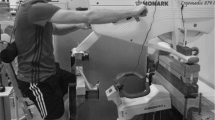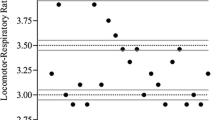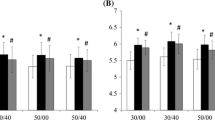Summary
Six muscular exercises, i.e., pedalling sitting (PS), cranking sitting (CS), pedalling and cranking (PCC), cranking standing (CST), pedalling reclining (PR), and pedalling with back support (PBS) were compared to see the relationship between work patterns and bodily reactions. Five young males volunteered in the study. CST, CS, PR, PS, and PBS yielded 76, 72, 72, 87, and 97% of\(\dot V_{{\text{O}}_{\text{2}} {\text{max}}}\) (PCC) respectively. Power output in arm work was about 70% of leg work. The ratio of\(\dot V_E /\dot V_{{\text{O}}_{\text{2}} {\text{max}}}\) in PS and PCC varied only between 22–24, while in CST, CS, PR, and PBS the ventilation equivalent decreased with the severity of exercise. At 40%\(\dot V_{{\text{O}}_{\text{2}} {\text{max}}}\) (CST, CS, PR, and PBS) and 70%\(\dot V_{{\text{O}}_{\text{2}} {\text{max}}}\) (CST, PR, and PS) the heart rates were about 145 beats·min−1 and 155 beats·min−1 respectively. Blood pressure was less in arm work than in leg work. PCC had a compensatory mechanism in lowering systolic blood pressure. At\(\dot V_{{\text{O}}_{\text{2}} {\text{max}}}\) (PBS), the O2 debt was 8.911, and 3.96 and 6.48 l respectively at 40 and 70%\(\dot V_{{\text{O}}_{\text{2}} {\text{max}}}\) (PBS); next highest values were observed in PR and CS, indicating inclusion of more isometric work component in CS, PR, and PBS. Slow component of the recovery\(\dot V_{{\text{O}}_{\text{2}} {\text{max}}}\) contributed largely to the total O2 debt. The net mechanical efficiency in most exercises ranged within 14–21%. At 40%\(\dot V_{{\text{O}}_{\text{2}} {\text{max}}}\) the efficiency was high followed by a fall at 70%\(\dot V_{{\text{O}}_{\text{2}} {\text{max}}}\) and again at\(\dot V_{{\text{O}}_{\text{2}} {\text{max}}}\) a marginal improvement in efficiency was noted. Arm and leg work were better performed in upright sitting posture. PCC was beneficial to improve\(\dot V_{{\text{O}}_{\text{2}} {\text{max}}}\) and to balance the physiological reactions.
Similar content being viewed by others
References
Amundsen LR, Takahashi M, Carter CL, Neilsen DH (1980) Exercise response during wall-pulley versus bicycle ergometer work. Phys Ther 60: 173–178
Asmussen E, Hemmingsen J (1958) Determination of maximum working capacity at different ages in work with the legs or with the arms. Scand J Clin Lab Invest 10: 67–71
Astrand PO, Ekblom B, Messin B, Saltin B, Stenberg J (1965) Intra-arterial blood pressure during exercise with different muscle groups. J Appl Physiol 20: 253
Astrand PO, Rodhal K (1970) Textbook of work physiology. McGraw Hill, New York
Astrand PO, Saltin B (1961) Maximal oxygen uptake and heart rate in various types of muscular exercise. J Appl Physiol 16: 977–998
Bar-Or O, Zwiren LD (1975) Maximal oxygen consumption test during arm exercise — reliability and validity. J Appl Physiol 38: 424–426
Bevegard S, Freyschuss U, Strandell T (1966) Circulatory adaptation to arm and leg exercise in supine and sitting position. J Appl Physiol 21: 37–46
Davies CTM, Di Prampero PE, Cerretelli P (1972) Kinetics of cardiac output and respiratory gas exchange during exercise and recovery. J Appl Physiol 32: 618–625
Davies CTM, Sargeant AJ (1975) Effects of training on the physiological responses to one- and two leg work. J Appl Physiol 38: 377–381
Duner H (1959) Oxygen uptake and working capacity during work on the bicycle ergometer with one or both legs. Acta Physiol Scand 46: 55–61
Freyschuss V, Strandeil T (1968) Circulatory adaptation to one- and two leg exercise in supine position. J Appl Physiol 25: 511–515
Gleser M, Horstman DH, Mello PP (1974) The effect on\(\dot V_{{\text{O}}_{\text{2}} {\text{max}}}\) of adding arm work to maximal leg work. Med Sci Sports 6: 104–107
Hagberg JM, Hickson RC, Ehsani AA, Holloszy JO (1980) Faster adjustment to and recovery from submaximal exercise in the trained state. J Appl Physiol 48: 218–224
Henry FM, DeMoor J (1950) Metabolic efficiency of exercise in relation to work load at constant speed. J Appl Physiol 2: 481–487
Henry FM, DeMoor J (1956) Lactic and alactic oxygen consumption in moderate exercise of graded intensity. J Appl Physiol 8: 606–614
Hildebrand FB (1956) Introduction to numerical analysis. Tata McGraw Hill, Bombay
Knuttgen HG (1970) Oxygen debt after submaximal physical exercise. J Appl Physiol 29: 651–657
Margaria R, Cerretelli P, Di Prampero PE, Massari C, Torelli G (1963) Kinetics and mechanism of oxygen debt contraction in man. J Appl Physiol 18: 371–377
Margaria R, Edwards HT, Dill DB (1933) The possible mechanism of contracting and paying the oxygen debt and the role of lactic acid in muscular contraction. Am J Physiol 106: 689–715
Margaria R, Mangili F, Cuttica F, Cerretelli P (1965) The kinetics of the oxygen consumption of the onset of muscular exercise in man. Ergonomics 8: 49–54
Margaria R, Oliva RD, Di Prampero PE, Cerretelli P (1969) Energy utilization in intermittent exercise of supra maximal intensity. J Appl Physiol 26: 752–756
Nag PK (1981) Predicting maximal oxygen uptake of workers engaged in agricultural tasks. J Human Ergol 10: 25–33
Nag PK, Shah AK, Chatterjee SK (1978) A modified mechanical type of bicycle ergometer. Digest Int Symp Workshop on Biomedical Engineering, held in New Delhi, pp 164–165
Nag PK, Panikar JT, Malvankar MG, Pradhan CK, Chatterjee SK, (1982) Performance evaluation of lower extremity disabled people in hand-cranked tricycle propulsion. Appl Ergonomics 13: 171–176
Reybrouck T, Heigenhauser GF, Faulkner JA (1975) Limitations in maximal oxygen uptake in arm, leg and combined arm-leg ergometry. J Appl Physiol 38: 774–779
Ricci B (1970) Physiological basis of human performance. Lea and Febiger, Philadelphia, pp 181–183, 262–265
Scher NH, Ruberg-Larsen N, Binkhorst RA, Bonde-Petersen F (1974) Maximal oxygen uptake during arm cranking and combined arm plus leg exercise. J Appl Physiol 36: 515–518
Sen RN, Ray GG, Nag PK (1978) Relationship between segmental and whole body weights of some Indian subjects. In: Shephard RJ, Lavallee H (eds) Physical fitness assessment. C. C. Thomas, Springfield, pp 384–391
Simmons R, Shephard RJ (1971) Measurement of cardiac output in maximum exercise, application of an acetylene rebreathing method to arm and leg exercise. Int Z Angew Physiol 29: 159–172
Stenberg J, Astrand PO, Ekblom B, Royce J, Saltin B (1967) Hemodynamic response to work with different muscle groups, sitting and standing. J Appl Physiol 22: 61–70
Taylor HL, Haskell WL, Fox SM, Balckburn H (1969) Exercise test: a summary of procedures and concepts of stress testing for cardiovascular diagnosis and function evaluation. In: Blackburn E (ed) Measurement in exercise electrocardiography. C. C. Thomas, Springfield
Vokac Z, Bell H, Bautz-Hoiter E, Rodhal K (1975) Oxygen uptake/heart rate relationship in leg and arm exercise, sitting and standing. J Appl Physiol 39: 54–59
Von Dobeln W (1954) A simple bicycle ergometer. J Appl Physiol 7: 222–224
Wiley R, Lind AR (1971) Respiratory responses to sustained static muscular contractions in humans. Clin Sci 40: 221–234
Author information
Authors and Affiliations
Rights and permissions
About this article
Cite this article
Kumar Nag, P. Circulo-respiratory responses to different muscular exercises. Europ. J. Appl. Physiol. 52, 393–399 (1984). https://doi.org/10.1007/BF00943369
Accepted:
Issue Date:
DOI: https://doi.org/10.1007/BF00943369




